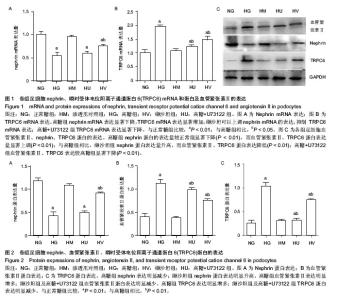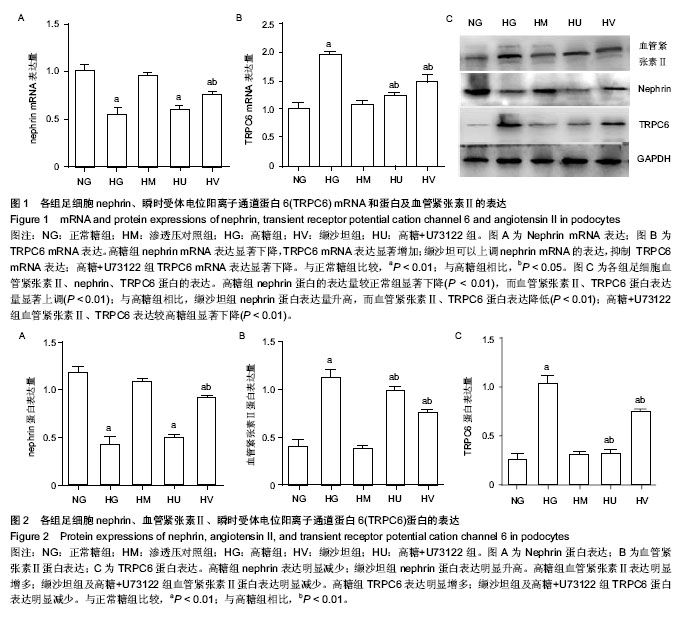| [1] Shaw JE, Sicree RA, Zimmet PZ, et al.Global estimates of the prevalence of diabetes for 2010 and 2030. Diabetes Res Clin Pract.2010;87 (1): 4-14.
[2] Vejakama P, Thakkinstian A, Lertrattananon D, et al. Reno-protective effects of reninangiotensin system blockade in type 2 diabetic patients:a systematic review and network meta-analysis. Diabetologia. 2012;55 (3): 566-578.
[3] Winn MP, Conlon PJ, Lynn KL, et al. A mutation in the TRPC6 cation channe causes familialfocal segmental glomerulosclerosis. Science.2005;306 (9):1801-1804.
[4] Reiser J,Polu KR,Moller CC,et al.TRPC6 is a glomerular slit diaphragm-associated chann el required for normal renal function. Nat Genet. 2005;37 (7): 739-744.
[5] Mundel P, Shankland SJ. Podocyte biology and response to injury. J Am Soc Nephrol. 2002;13 (12): 3005-3015.
[6] Asanuma K, Mundel P.The role of podocytes in glomerular pathobiology. Clin Exp Nephrol.2003;7 (4): 255-259.
[7] Reiser J, Kriz W, Kretzler M, et al. The glomerular slit diaphragm is a modified adherens junction. J Am Soc Nephrol. 2000;11 (1): 1-8.
[8] Patrakka J, Tryggvason K. Molecular make-up of the glomerular filtration barrier. Biochem Biophys Res Commun. 2010;396 (1):164-169.
[9] Pavenstädt H, Kriz W, Kretzler M.Cell biology of the glomerular podocyte. Physiol Rev.2003;83(3): 253-307.
[10] Dalla Vestra M, Masiero A, Roiter AM, et al. Is podocyte injury relevant in diabetic nephropathy? Studies in patients with type 2 diabete s. Diabetes. 2003;52(4):1031-1035.
[11] Roshanravan H, Dryer SE. ATP acting through P2Y receptors causes activation of podocyte TRPC6 channels: role of podocin and reactive oxygen species. Am J Physiol Renal Physiol.2014;306(9):F1088-1097.
[12] Kobori H, Nangaku M, Navar LG, et al. The intrarenal renin- angiotensin system: from physiology to the pathobiology of hypertension and kidney disease. Pharmacol Rev.2007;59 (3):251-287.
[13] Njenhuis T,Sloan AJ,Hoenderop JG,et al.Hoenderop, Angiotensin II Contributes to Podocyte Injury by Increasing TRPC6 Expression via an NFAT-Mediated Positive Feedback Signaling Pathway. The American Journal of Pathology. 2011; 179(4):1719-1732.
[14] Moller CC, Flesche J, Reiser J, et al.Sensitizing the slit diaphragm with TRPC6 ion channels.J Am Soc Nehprol. 2009; 20(5):950-953.
[15] Yu L,Lin Q,Liao H,et al.TGF-β1 Induces Podocyte Injury Through Smad3-ERK-NF-κB Pathway and Fyn-dependent TRPC6 phosphorylation. Cell Physiol Biochem.2010;269(6): 869-878.
[16] 彭晖,张俊,王成,等.血管内皮细胞生长因子激活Racl引起肾小球内皮细胞通透性增高的机制[J].中华肾脏病杂志,2009,25(2): 111-115.
[17] Eckel J, Lavin PJ, Finch EA, et al. TRPC6 enhances angiotensin II-induced albuminuria. J Am Soc Ne phrol.2011; 22(3):526-535.
[18] Itsuki K, Imai Y, Hase H, et al. PLC-mediated PI(4,5)P2 hydrolysis regulates activation and inactivation of TRPC6/7 channels. J Gen Physiol.2014;143(2):183-201.
[19] Jiang L, Ding J, Tsai H, et al. Over-expressing transient receptor potential cation channel 6 in podocytes induces cytoskeleton rearrangement through increases of intracellular Ca2+ and RhoA activation.Exp Biol Med (Maywood).2011;236 (2): 184-193.
[20] Ilatovskaya DV, Palygin O, Chubinskiy-Nadezhdin V, et al. Angiotensin II has acute effects on TRPC6 channels in podocytes of freshly isolated glomeruli.Kidney Int, 2014. [Epub ahead of print].
[21] Yang H, Zhao B, Liao C, et al. High glucose-induced apoptosis in cultured podocytes involves TRPC6-dependent calcium entry via the RhoA/ROCK pathway. Biochem Biophys Res Commun.2013;434(2):402-408.
[22] Somineni HK, Boivin GP, Elased KM. Daily exercise training protects against albuminuria and angiotensin converting enzyme 2 shedding in db/dbdiabetic mice. J Endocrinol. 2014; 221(2):235-251.
[23] Kuangxin Yu, Huangwen Yan. TRPC6 and kidney diseases. Int J Pathol Clin Med. 2008;28(9):0456-0460.
[24] Gyires K, Rónai AZ, Zádori ZS, et al. Angiotensin II-induced activation of central AT1 receptors exerts endocannabinoid- mediated gastroprotective effect in rats. Mol Cell Endocrinol. 2014;382(2):971-978. |

